|
Turn to next page >>
|
|
(click picture for enlargement)
|
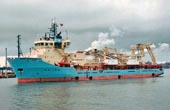 |
"Maersk Forwarder" equipped as a cable laying vessel. In 1999 "Maersk Forwarder" was rebuild as a
cable layer, and sailed as such a couple of years. Today the ship has been brought back to its
original state.
(Not my picture) |
 |
"Maersk Fetcher", a sistership. After being stripped of its cable laying equipment "Maersk
Forwarder" looks like this sistership again.
(Not my picture) |
 |
"Maersk Forwarder" along side in Aberdeen, Scotland. When she was new in 1992, she was actually considered a rather large platform supply vessel. Today,
there are still only few larger ones, although the anchor handlers/tugs are now often bigger. |
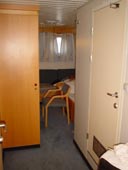 |
My cabin, the smallest one I've ever lived in but still quite cozy. The round windows added a certain charm. The door on the right leads into my own
bathroom. |
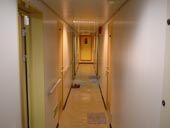 |
A look down the corridor, which went fore-and-aft. The accommodation was four decks high; main deck, two cabin decks and the bridge. |
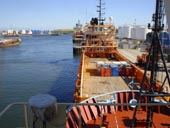 |
A look from the bridge of Maersk Forwarder in the Port of Aberdeen. Aberdeen is a very busy port and serves as base for many supply ships. The port was nearly
always full when we were there. |
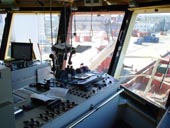 |
The aft manouvering console. When the ship is working along side rigs at sea, the ship is manouvered from here. I spent several hours in the chair here manouvering the ship, it's quite interesting! |
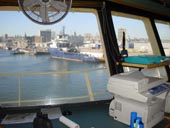 |
It's a very short distance from the port and into town, which makes Aberdeen popular among crews. |
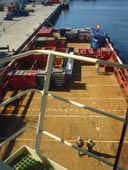 |
The main deck, during loading of deck cargo. People from the port place the boxes, pipes and other cargo according to a plan made by the ship's deck officers.
The cargo is grouped according to destination, so when you reach the oil platforms, it's easy for the rigs' crane drivers to see what cargo to take. |
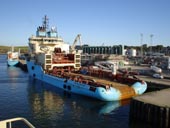 |
The anchor handling tug vessel Maersk Assister. To learn more about these ships and how they work, check out my brother's page. |
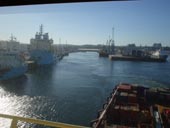 |
With all the cargo on board, we left the Port of Aberdeen and headed towards the oil fields and production platforms. To the left is Maersk Assister. |
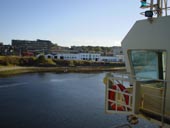 |
On the way out of the port on a fine autumn afternoon. The life belt is a so-called man-over-board-bouy and can be remotely released from the bridge.
When released, it drags with it a light and smoke signal, making it easier to find a person lost over the side. |
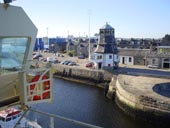 |
Port of Aberdeen Harbour Control have their control center in this building, overlooking the port. |
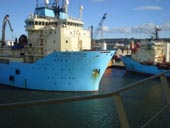 |
Maersk Achiever (a sistership to Maersk Assister) and in the background Maersk Fetcher (a sistership to Maersk Forwarder). The difference in the size of the ships is clear in this picture. |
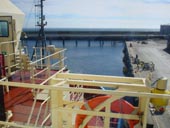 |
The shortest port stay I have ever experienced, this 15-minute rendevouz with the port in Peterhead served the purpose of loading one container, appearantly containing essential equipment for a drilling platform. |
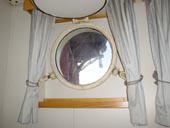 |
A look at the Murchison production platform through my cabin window. When alongside rigs the azimut thruster was constantly in use. This meant
a lot of noise in my cabin, which took some getting used to during night time. |
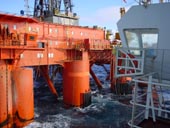 |
The Deepsea Bergen semi-submersible drilling rig from 1983. Semi-submersible means that the rig can take in water for ballast, thus submerging huge pontoons on the
end of the legs. Only the thin legs carrying the platform deck will then be above water, as seen on this picture. By doing this, the rig will be very still in the water
even in rather rough seas. |
 |
When the semi-submersible is to be moved, they pump out the ballast bringing the pontoons to the surface. They are then towed or moved under own power, if equipped
to do so. |
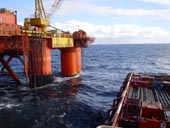 |
As part of the cargo operation, it is often necessary to transfer liquids like oil, fresh water, brine, drilling mud etc. to the platforms. For this purpose hoses are connected from the platform to the supply vessel. Here, such a hose can be seen in the water, as we supply diesel oil to Deepsea Bergen, probably to be used for their diesel-driven electric power generators. |
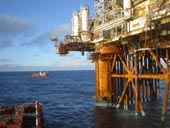 |
The oil production platfrom "Thistle Alpha". We brought supplies to this platform on a weekly basis.
(PLEASE NOTE THIS PICTURE IS COPYRIGHTED) |
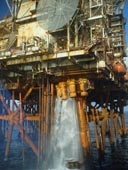 |
Another view of the massive "Thistle Alpha" platform. In november 2007 a fire broke out on this platform, and the crew was partly evacuated.
(PLEASE NOTE THIS PICTURE IS COPYRIGHTED) |
 |
The fairly empty working deck / cargo area of the Maersk Forwarder, as we go along side production platform Deepsea Bergen. |
 |
Our ship would remain manually manouvered while along side, approximately this distance, during the cargo operation. Maersk Forwarder did not use Dynamic Positioning when alongside BP platforms in the North Sea, so it was down to manual joystick control. |
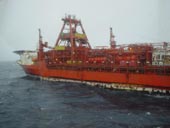 |
Approaching a FPSO (Floating Production, Storage and Off-loading vessel) in fairly rough weather. We were supposed to deliver some supplies to this vessel, but ultimately had to abort the operation due to weather conditions. |
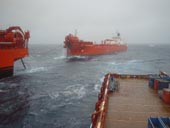 |
Tanker Petroatlantic located aft of the FPSO. The tanker works as a "shuttle tanker", loading oil from the FPSO and transporting this to a nearby port (the FPSO is not connected to shore pipelines). The black hose connecting the vessels can be clearly seen. |
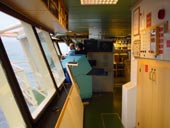 |
The Captain (blue boiler suit) at the aft manouvering console during this tricky FPSO approach. |
| Turn to next page >> |